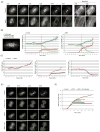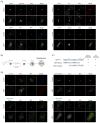KIF4 regulates midzone length during cytokinesis
- PMID: 21565503
- PMCID: PMC3100440
- DOI: 10.1016/j.cub.2011.04.019
KIF4 regulates midzone length during cytokinesis
Abstract
Background: Midzones, also called central spindles, are an array of antiparallel microtubules that form during cytokinesis between the separated chromosomes. Midzones can be considered to be platforms that recruit specific proteins and orchestrate cytokinetic events, such as sister nuclei being kept apart, furrow ingression, and abscission. Despite this important role, many aspects of midzone biology remain unknown, including the dynamic organization of midzone microtubules. Investigating midzone microtubule dynamics has been difficult in part because their plus ends are interdigitated and buried in a dense matrix, making them difficult to observe.
Result: We employed monopolar cytokinesis to reveal that midzone plus ends appear to be nondynamic. We identified the chromokinesin KIF4 as a negative regulator of midzone plus-end dynamics whose activity controls midzone length but not stability. KIF4 is required to terminate midzone elongation in late anaphase. In the absence of KIF4, midzones elongate abnormally, and their overlap regions are unfocused. Electron-dense material and midbodies are both absent from the elongated midzones, and actin filaments from the furrow cortex are not disassembled after ingression.
Conclusion: KIF4-mediated midzone length regulation appears to occur by terminating midzone elongation at a specific time during cytokinesis, making midzones and mitotic spindles differ in their dynamics and length-regulating mechanisms.
Copyright © 2011 Elsevier Ltd. All rights reserved.
Figures






Similar articles
-
Cell cycle-dependent translocation of PRC1 on the spindle by Kif4 is essential for midzone formation and cytokinesis.Proc Natl Acad Sci U S A. 2005 Jan 11;102(2):343-8. doi: 10.1073/pnas.0408438102. Epub 2004 Dec 29. Proc Natl Acad Sci U S A. 2005. PMID: 15625105 Free PMC article.
-
A novel immunofluorescence method to visualize microtubules in the antiparallel overlaps of microtubule-plus ends in the anaphase and telophase midzone.Exp Cell Res. 2017 Nov 15;360(2):347-357. doi: 10.1016/j.yexcr.2017.09.025. Epub 2017 Sep 20. Exp Cell Res. 2017. PMID: 28942021
-
Proper organization of microtubule minus ends is needed for midzone stability and cytokinesis.Curr Biol. 2010 May 11;20(9):880-5. doi: 10.1016/j.cub.2010.03.067. Epub 2010 Apr 29. Curr Biol. 2010. PMID: 20434340 Free PMC article.
-
Midbodies and phragmoplasts: analogous structures involved in cytokinesis.Trends Cell Biol. 2005 Aug;15(8):404-13. doi: 10.1016/j.tcb.2005.06.003. Trends Cell Biol. 2005. PMID: 16009554 Free PMC article. Review.
-
Centralspindlin in Rappaport's cleavage signaling.Semin Cell Dev Biol. 2016 May;53:45-56. doi: 10.1016/j.semcdb.2016.03.006. Epub 2016 Mar 7. Semin Cell Dev Biol. 2016. PMID: 26964770 Review.
Cited by
-
Lateral and longitudinal compaction of PRC1 overlap zones drives stabilization of interzonal microtubules.Mol Biol Cell. 2023 Sep 1;34(10):ar100. doi: 10.1091/mbc.E23-02-0049. Epub 2023 Jul 19. Mol Biol Cell. 2023. PMID: 37467037 Free PMC article.
-
Increased KIF4A expression is a potential prognostic factor in prostate cancer.Oncol Lett. 2018 May;15(5):7941-7947. doi: 10.3892/ol.2018.8322. Epub 2018 Mar 22. Oncol Lett. 2018. PMID: 29725481 Free PMC article.
-
The kinesin-8 Kip3 scales anaphase spindle length by suppression of midzone microtubule polymerization.J Cell Biol. 2014 Mar 17;204(6):965-75. doi: 10.1083/jcb.201312039. Epub 2014 Mar 10. J Cell Biol. 2014. PMID: 24616221 Free PMC article.
-
The role of Kif4A in doxorubicin-induced apoptosis in breast cancer cells.Mol Cells. 2014 Nov;37(11):812-8. doi: 10.14348/molcells.2014.0210. Epub 2014 Nov 5. Mol Cells. 2014. PMID: 25377255 Free PMC article.
-
Spindle-to-cortex communication in cleaving, polyspermic Xenopus eggs.Mol Biol Cell. 2015 Oct 15;26(20):3628-40. doi: 10.1091/mbc.E15-04-0233. Epub 2015 Aug 26. Mol Biol Cell. 2015. PMID: 26310438 Free PMC article.
References
-
- Bringmann H. Cytokinesis and the spindle midzone. Cell Cycle. 2005;4:1709–1712. - PubMed
Publication types
MeSH terms
Substances
Grants and funding
LinkOut - more resources
Full Text Sources
Molecular Biology Databases
Miscellaneous

